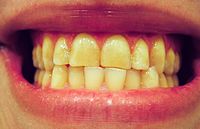
Photo from wikipedia
INTRODUCTION Occlusal overload is considered to be one of the causes of late implant failure. However, it is unclear whether the magnitude of the patient's occlusal force is a risk… Click to show full abstract
INTRODUCTION Occlusal overload is considered to be one of the causes of late implant failure. However, it is unclear whether the magnitude of the patient's occlusal force is a risk factor for late implant failure. PURPOSE This case-control study aimed to clarify the association between the cross-sectional area (CSA) of the masseter muscle and late implant failure. METHODS This case-control study was limited to implant-supported fixed prostheses. We compared cases with at least one late implant failure (n = 25 patients) to controls (n = 82 patients) without implant failure. Patients were matched by age, sex, year of surgery, jaw and tooth type, and bone graft. Log-rank and Cox proportional hazard regression analyses were used to identify possible risk factors for late implant failure. RESULTS The incidence of late implant failure was significantly associated with masseter muscle CSA ≥504.5 mm2 (hazard ratio: 4.43; 95% CI: 1.82-10.79; p < 0.01). CONCLUSION Higher masseter muscle CSA increases the risk of late implant failure.
Journal Title: Clinical implant dentistry and related research
Year Published: 2023
Link to full text (if available)
Share on Social Media: Sign Up to like & get
recommendations!